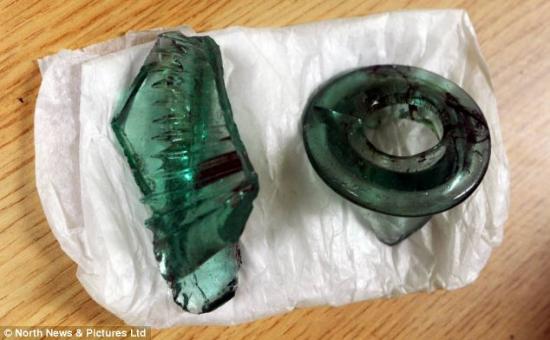PART.2

Roman glass from a drinking vessel, was also uncovered near Cataractonium. Finds preceding the glass by thousands of years were additionally discovered nearby
Dere Street, which was built by the Romans, runs alongside the modern A1 and the experts are focusing their efforts on a Roman town located by the road near to the River Swale, called Cataractonium. They have so far discovered evidence of Iron Age, Mesolithic and Neolithic settlements. Sherlock said: ‘The road scheme is 12 miles (19km) long and we are investigating a number of different sites."It was fascinating to find that one of those was in fact a Mesolithic site, a further 8,000 years into the past, beyond the Romans. ‘We are still finding extremely clear evidence of how people used to live here almost 2,000 years ago during the Roman period.’ The team has discovered buildings on the edge of Dere Street, including shop frontages and even a bath house.

This flint tool, which dates between 6000 and 8000 BC was also discovered at the site close to the busy A road
‘We think this was a particularly industrial part of the town,’ he said. "Finds during the excavations have included a complete Roman bowl called a Mortaria used for grinding herbs and spices. Another was Roman glass from a drinking vessel, found in Cataractonium.’ Approximately half a mile )0.8km) further south from Cataractonium, is evidence of Iron Age settlements and Iron Age cremations. Redfearn added: ‘This is really interesting because we weren't quite expecting to find Iron Age material here either. ‘In pre-work, we have done quite a lot of studying at desktop level to try to understand what the level of archaeology of the landscape was actually like."To find an Iron Age settlement with Iron Age activity and even cremations gives us an inkling again as to what life was like before the Roman period.’
ARCHAEOLOGICAL DISCOVERIES
A Mesolithic settlement has been uncovered beside the A1 in North Yorkshire. The site is believed to have been a kind of overnight shelter used by people travelling north and south thousands of years ago.
A number of flint tools dating back to between 6000 and 8000 BC were also discovered at the site.
Evidence of Iron Age, Mesolithic and Neolithic settlements have been found near the Roman town of Cataractonium, near the River Swale.
The team has discovered buildings on the edge of Dere Street - a Roman road running alongside the A1 - including shop frontages and even a bath house.
Finds during the excavations have included a complete Roman bowl called a Mortaria used for grinding herbs and spices.
Roman glass from a drinking vessel has also been found at the site of the Roman town.
Approximately half a mile further south from Cataractonium, is evidence of Iron Age settlements and Iron Age cremations.